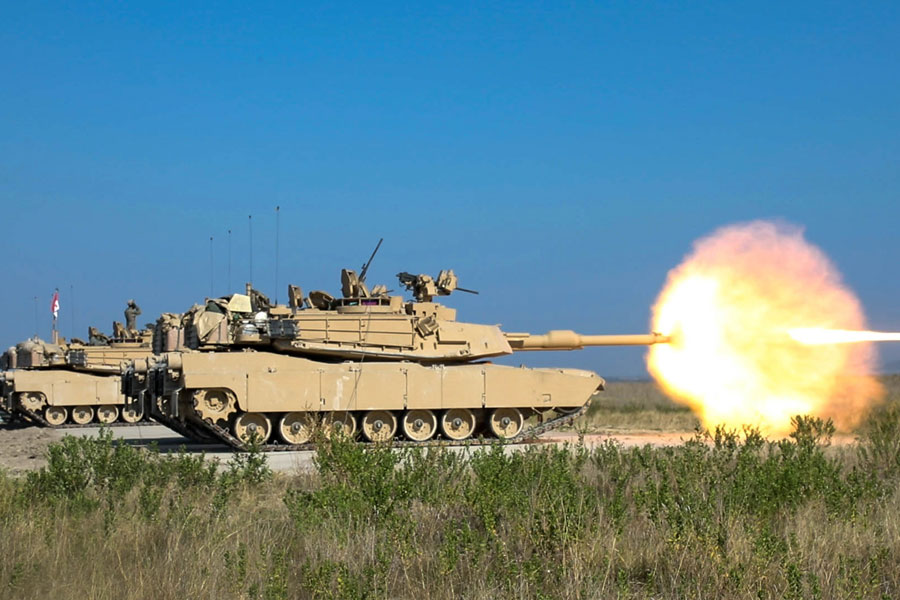
Poland to Buy $6 Billion in US-made
Tanks, Assault Bridges, and Explosives
Tara Copp / Defense One
(February 19, 2022) — Defense Secretary Lloyd Austin announced Friday that the US will sell 250 M1A2 Abrams tanks to Poland to further build up defense capabilities along NATO’s eastern flank with Russia as US officials continue to warn that an attack against Ukraine is imminent.
Russian-backed separatists and Ukrainian government forces have exchanged intensified shelling over the last two days in Eastern Ukraine, which US and NATO officials have said could be used as a pretext for a larger Russian attack.
Austin announced the $6 billion contract during a stop in Warsaw to meet with Polish Minister of National Defense Mariusz Blaszczak. Beyond the tanks, the contract includes the sale of 250 counter-IED systems, 26 M88 combat recovery vehicles, 17 joint assault bridges, 276 M2 .50-caliber machine guns, and thousands of rounds of explosive tracers.
“This is the most modern version of the Abrams and will provide Poland with a highly advanced tank capability that will also strengthen our interoperability with the Polish armed forces, boosting the credibility of our combined deterrence efforts in those of other NATO allies,” Austin said.
The announcement comes as Mike Carpenter, US ambassador to the Organization for Security and Cooperation in Europe, said that Russia’s troops along the Ukrainian border had rapidly swelled to as many as 190,000 forces.
“This estimate includes military troops along the border, in Belarus, and in occupied Crimea; Russian National Guard and other internal security units deployed to these areas; and Russian-led forces in eastern Ukraine,” the OSCE said Friday in a statement. “This is the most significant military mobilization in Europe since the Second World War.”
Blaszczak said the Abrams sale is part of Poland’s newly expanded homeland defense spending that will finance the modernization of Polish armed forces. In October, Poland announced it would double its number of active duty forces to roughly 200,000 and increase its defense budget from 2.2 percent to 2.5 percent of its GDP.
Russian troops assembled along Ukraine’s border have not advanced on Kyiv.
If Russia further invades Ukraine, “Poland could see tens of thousands of displaced Ukrainians and others flowing across its border trying to save themselves and their families from the scourge of war,” Austin said.
US military airlift could be used to assist refugees who flee to Poland or other locations if requested, Air Force Chief of Staff Gen. C.Q. Brown told Defense One on Thursday.
“It’s our responsibility as a service to be prepared to provide airpower at the request of the combatant commands and at the direction of the President,” Brown said in a later statement to Defense One. “We plan for any number of contingencies, and this is no different, but the President has been clear, should Russia invade Ukraine – there are no plans to conduct a mass evacuation.”
Blaszczak said Poland will take in refugees fleeing Ukraine.
“We are ready. We are ready to help all those who will be forced to leave Ukraine,” he said. “We, as a nation that has so strongly and badly experienced World War II, we know what support is all about.”
Related Articles
- Biden Says Russia Will Attack Within ‘Several Days;’ Blinken Lobbies For Peace at UN
- US Companies Warned to Prepare for Russian Cyber Attacks
- Biden Should Shift US Troop Positions Worldwide

Comments
Working Overtime!
Colleen Rowley
And it’s all Eisenhower’s fault for just talking about this burgeoning conflict of interest problem instead of doing something when it was still possible to nip it in the bud. Now like the bloodthirsty plant in “Little Shop of Horrors,”
MICIMATT has spread its tentacles and grown too big and monstrous to easily cut down. See this excellent Quincy panel: Who’s Afraid of the Military Industrial Complex? – YouTube suggesting that the solution lies in nationalizing it. (Except most of the MICIMATT components in US-NATO: Corporate Media, Think Tank, Academia are already effectively “nationalized” as corporate war profiteers.)
Getting the Message Out
Donald Smith
The Quincy Institute video Who’s Afraid of the Military Industrial Complex? – YouTube that Coleen shared has gotten 424 views and 37 likes. A music video or a cat video often gets millions of views. Apparently not many people are afraid of the MiC, maybe because they think the topic is BORING. Well, the video has been there for two days only.
In the video, William Hartung, senior research fellow at the Quincy Institute, mentions that the National Defense Industrial Association says that there were about 3 million direct jobs in the defense industry in the 1980s and it’s down to about 1 million now. So you’d hope the influence of the MiC should decrease.
The video discusses how the military contractors fund think tanks, which turn out research justifying their budgets. It discusses the revolving doors between the Pentagon, Congressional offices, and military contractors.
There are pressure groups like the Committee to Expand NATO, the Committee to Liberate Iraq, etc. Hartung mentions that in Congress there’s an F-35 caucus, even though the F-35 is a deeply troubled aircraft that is overpriced, hard to maintain, and may never be ready for combat. There’s also an ICBM caucus of senators who have ICBM bases in their districts. The Pentagon can’t pass an audit.
“The defense industry has tried to undermine the Independent Testing Office, one of the few places where we get the straight story of how these weapons perform and their cost.” The Pentagon budget emphasizes big budget items and under-funds maintenance. Hartung said we shouldn’t give into the temptation to throw up our hands, give up, and crawl into a fetal position.
The moderator mentions Ray McGovern’s term MICIMATT, the Military-Industrial-Congressional-Intelligence-Media-Academia-Think-Tank.
They also call it the “self-licking ice cream cone.”
The same necon hawks, such as Eliot Abrams, are recycled from one think tank and pressure group to another. Universities are going after scarce military funding. The tentacles of the MICIMATT extend everywhere.

You sometimes hear that arms exports give the US leverage over recipient countries’ policies. But that’s not the case, according to panelist Shana Marshall. “Egypt, Israel, and Saudi Arabia have flagrantly violated the most basic desires of the US foreign policy establishment over and over.” The US is not very democratic. The preferences of the public rarely get translated into policy.
Shana Marshall, associate director of the Institute for Middle East Studies at George Washington University, mentioned nationalizing the defense industries but chuckled and admitted it’s a “pie-in-the-sky” idea. There is a huge constituency of professionals whose entire life is dependent on militarism, and she said the only way to start to fix it is to remove the profit motive.
Marshall mentioned that the military industry is global, extending especially to the Middle East and through NATO expansion. These are transnational corporate actors for whom any expansion is good business. The MiC was frenzied about the expansion of NATO to assure contracts. It happens in Africa too. So we rarely see a peace dividend. There’s not even real competition; there are joint venture contracts and outsourcing, and they get paid anyway.
The moderator says that most people would agree that “the system is absolutely broken. Not broken for the profit makers, but broken for American democracy.”
Michael Brenes, interim director of the Brady-Johnson Program in Grand Strategy and lecturer in history at Yale, discussed defense conversion (converting military jobs to civilian/commercial jobs) There was some success at that in the 1990s. He said it’s important to convert defense industries to good uses, with well-paid jobs and green industries. People in places like Alabama have complained about subsidized defense industries not producing many jobs and not making useful products.
John Kenneth Galbraith had an idea in the 1960s about nationalizing defense industries. They gave the example that when the pandemic closed supply chains through Mexico, the US couldn’t get parts that came from China, since the industry is international and outsourced: another reason the US doesn’t see many jobs. Globalization of the military industrial supply chain is great.
There have been growing moves in Congress to lower the military budget. A lot of former military personnel speak out against the MiC later in life, because they realize its faults. Many soldiers had to self-finance to purchase their own body armor in Iraq. It’s easier to hide price gouging in huge multi-billion dollar weapons systems than in contracts for body armor.
The public has some awareness that military spending is wasteful, especially given the costs of the covid pandemic. [When my member of Congress pointed to the trillions of dollars Congress spent on pandemic relief to justify higher military spending, I responded: the fact that we had to spend that money is even more reason not to waste money on the unneeded and dangerous weapons.]
“Do you remember the fly-over for front line workers that the Pentagon did early in the pandemic?” Marshall asked. She said that lots of people (front-line workers, nurses, and doctors) were angry at the cost of the fly-over when they lacked personal protection equipment, etc. So this got some coverage.
Both Brenes and the moderator joked about sometimes wanting to crawl up into a fetal position over the issues.
The last question was about media complicity. Hartung said the biggest problem is the unconscious assumptions that control the conversations. Editors think that contrary views aren’t socially viable. Lockheed Martin funded a report about industry consolidation: there are fewer firms. It wasn’t clear if that was due to mergers and acquisitions or to conversion to civilian industries. The Wall Street Journal twisted the findings to say that the US defense industry is at risk and it needs more funding to build it back up.
Posted in accordance with Title 17, Section 107, US Code, for noncommercial, educational purposes.